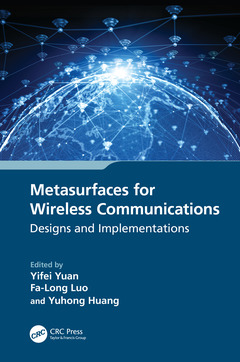Metasurfaces for Wireless Communications Designs and Implementations
Auteurs : Yuan Yifei, Huang Yuhong, Luo Fa-Long

This book provides a comprehensive coverage of reconfigurable intelligent surface (RIS) based wireless communications by covering all the technology stages from working principles, theories and algorithms, system architectures, real-world implementations, and programming platforms through performance measurements and system testing. Metasurfaces for Wireless Communications: Designs and Implementations serves as a must-be read for everything related to the use of RIS in wireless networks.
Authored by three experts in the field, the book is organized into five in-depth and well-designed chapters. The first chapter discusses the fundamentals of metasurfaces for wireless communications as well as the related evolution and requirements of RIS in 6G. The second chapter is devoted to the modeling and analyses of RIS for wireless communications by including electromagnetic field modeling and theoretical analyses of both large- and small-scale channel models. In Chapter 3, the authors mainly address properties? characterizations and system design of metasurface devices. Chapter 4 examines relay and system implementations of RIS for wireless communications through basic system models, key design aspects, and system simulations and architectures. Chapter 5 discusses the standardization of RIS-aided wireless communications by providing an overview of the relay technologies, field trials, and roadmaps in 3GPP standardizations.
This book serves not only as a comprehensive reference for professional engineers, researchers, manufacturers, network operators, software developers, service providers, and regulatory bodies aiming at the development, standardization, deployment, and applications of B5G and 6G mobile communications, but also as a textbook for graduate students in circuits, signal processing, wireless communications, information theory, microwave technology, and antenna and propagation.
Preface
About the Authors
Chapter 1: Fundamentals of Metasurfaces for Wireless Communications
Introduction of Metamaterial and Metasurface
Evolutions of Reconfigurable Intelligent Surface (RIS)–Related Wireless Technologies
- Multi-Antenna Technology
- Coordinated Multi-Point Processing (CoMP)
- Micro/Pico/femto Cells
- Relay
System Performance Requirements for 6G
- Application Scenarios
- Key Performance Indicators
- Basics about Performance Evaluation Methodologies
Chapter 2: Modeling of a RIS for Wireless Communications
Overview of Channel Models for Mobile Communications
- Large-Scale Fading Models
- Small-Scale Fading Models
- Spatial Channel Models
- Simplified Model for Spatial Channels
- Antenna Models and Configurations
Large-Scale Channel Models for a RIS
- Free-Space Pathloss Models for a RIS
- More Realistic Large-Scale Fading Models for RIS
Small-Scale Channel Models for RIS
Electromagnetic Field Modeling of Metasurface Structures
Chapter 3: Designs of Metasurface Devices
Basic Design Principles of Metasurface Devices
- Typical Metamaterials and Devices
- Basic Structures of Metamaterial Devices
- Design Principles of Metasurface
- Active RIS Elements
Simulations and Measurements of Metasurface Devices
- Electromagnetic Simulations
- Performance Testing of Actual Devices
Control of Metasurface Devices
- Non-Ideal Characteristics
- Control Mechanisms of Tunable Metasurface
Codebook Designs of the RIS
- Uniqueness of Codebook Design for the RIS
- Examples of the RIS Codebook Designs
Near-Field Communications
- Near-Field Basics
- Polar Coordinates for the Near-Field
- Beam Squinting in Wideband Operation and Solutions
Metasurface-Based Beamforming at the Base Station
Chapter 4: System Implementations of a RIS for Wireless Communications
Basic System Models and Performances for Metasurface-Based Relay
- System Models
- Theoretical Performance Analysis
- Simplified Model and Performance Analysis
Beamforming Techniques for a RIS
- Beam-Based Techniques
- Random-Sampling-Based Technique
RIS Channel Estimation and Feedback for Small-Scale Fading
Direction Finding Via Time-Space Coding
Link-Level Simulations
- Simulation Parameters and Methodology
- Preliminary Link-Level Simulation Results
System-Level Simulations
- System Configurations and Simulation
- Preliminary Simulation Results
Chapter 5: Standardization and Trials of RIS-Aided Wireless Communications
Overview and Key Features of Relay Technology in Standardization
- Potential Deployment Scenarios
- Basic Categories of an LTE Relay
- Type 1 Relay
- Type 2 Relay
Brief Discussion on an LTE Full-Dimensional MIMO
Field Trials
- RIS Trial in Nanjing
- RIS Trial in Shenzhen
Standardization Road Map for the RIS
- Lessons Learned from the LTE Era
- Different Modes of Operation for the RIS
- 3GPP Release 18 Network-Controlled Repeater
- Comparison Between Network-Controlled Repeater and RIS
- Future Road Map for RIS Standardization
Index
Dr. Yifei Yuan holds the title of Chief Expert of China Mobile Research Institute. He received his Bachelor & Master degrees from Tsinghua University, of China, and a Ph. D degree from Carnegie Mellon University, USA. He was with Alcatel-Lucent from 2000 to 2008, working on 3G/4G key technologies. From 2008 to 2020, he was with ZTE as technical director and Chief Engineer, responsible for standards research on LTE-Advanced and 5G. Since January 2020, he has been with China Mobile Research Institute, responsible for advanced research of 6G air interface. His research interests include MIMO, channel coding, non-orthogonal multiple access (NOMA), internet-of-things (IoT), and their standardizations in 3GPP with receiving worldwide attention and recognition. He has more than 80 journal/conference papers and 150 granted patents. He is the Editor-in-Chief of Hans Wireless Communications, an Editor of IEEE Communications Letters and an Editor of China Communications. He is the leading Guest Editor of Special Issue on Reconfigurable Intelligent Surface (RIS) of ZTE Communications (Vol. 20, No.1, 2022) and TPC member of GLOBECOM 2022 RIS symposium (on going). He serves as Industry Liaison Officer of IEEE Emerging Technology Initiative (ETI) on RIS.
Yuhong Huang is the General Director of China Mobile Research Institute where she has been since 1996, Mrs.Yuhong Huang also serves as a member of Board of Directors of NGMN and O-RAN alliance. She received her Bachelor & Master degrees from Beijing University of Posts and Telecommunications, of China. She has been a China national technical leader with being responsible for GSM, WLAN, 3G through to 5G and 6G research and development. She won 20 awards from China Central Government, including a National Special Prize for Scientific and Technological Progress on 4G TD-LTE (7th contributor). She has been admitted to “The New Century Talents Project” and granted the honors of “Young Professionals with Outstanding Co
Date de parution : 04-2024
15.6x23.4 cm



